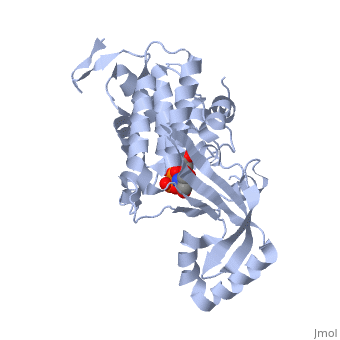2nun: Difference between revisions
New page: left|200px <!-- The line below this paragraph, containing "STRUCTURE_2nun", creates the "Structure Box" on the page. You may change the PDB parameter (which sets the PD... |
No edit summary |
||
| (9 intermediate revisions by the same user not shown) | |||
| Line 1: | Line 1: | ||
< | ==The structure of the type III effector AvrB complexed with ADP== | ||
<StructureSection load='2nun' size='340' side='right'caption='[[2nun]], [[Resolution|resolution]] 2.40Å' scene=''> | |||
You may | == Structural highlights == | ||
<table><tr><td colspan='2'>[[2nun]] is a 1 chain structure with sequence from [https://en.wikipedia.org/wiki/Pseudomonas_savastanoi_pv._glycinea Pseudomonas savastanoi pv. glycinea]. Full crystallographic information is available from [http://oca.weizmann.ac.il/oca-bin/ocashort?id=2NUN OCA]. For a <b>guided tour on the structure components</b> use [https://proteopedia.org/fgij/fg.htm?mol=2NUN FirstGlance]. <br> | |||
</td></tr><tr id='method'><td class="sblockLbl"><b>[[Empirical_models|Method:]]</b></td><td class="sblockDat" id="methodDat">X-ray diffraction, [[Resolution|Resolution]] 2.4Å</td></tr> | |||
<tr id='ligand'><td class="sblockLbl"><b>[[Ligand|Ligands:]]</b></td><td class="sblockDat" id="ligandDat"><scene name='pdbligand=ADP:ADENOSINE-5-DIPHOSPHATE'>ADP</scene>, <scene name='pdbligand=TRS:2-AMINO-2-HYDROXYMETHYL-PROPANE-1,3-DIOL'>TRS</scene></td></tr> | |||
<tr id='resources'><td class="sblockLbl"><b>Resources:</b></td><td class="sblockDat"><span class='plainlinks'>[https://proteopedia.org/fgij/fg.htm?mol=2nun FirstGlance], [http://oca.weizmann.ac.il/oca-bin/ocaids?id=2nun OCA], [https://pdbe.org/2nun PDBe], [https://www.rcsb.org/pdb/explore.do?structureId=2nun RCSB], [https://www.ebi.ac.uk/pdbsum/2nun PDBsum], [https://prosat.h-its.org/prosat/prosatexe?pdbcode=2nun ProSAT]</span></td></tr> | |||
</table> | |||
== Function == | |||
[https://www.uniprot.org/uniprot/AVRB_PSESG AVRB_PSESG] | |||
== Evolutionary Conservation == | |||
[[Image:Consurf_key_small.gif|200px|right]] | |||
Check<jmol> | |||
<jmolCheckbox> | |||
<scriptWhenChecked>; select protein; define ~consurf_to_do selected; consurf_initial_scene = true; script "/wiki/ConSurf/nu/2nun_consurf.spt"</scriptWhenChecked> | |||
<scriptWhenUnchecked>script /wiki/extensions/Proteopedia/spt/initialview01.spt</scriptWhenUnchecked> | |||
<text>to colour the structure by Evolutionary Conservation</text> | |||
</jmolCheckbox> | |||
</jmol>, as determined by [http://consurfdb.tau.ac.il/ ConSurfDB]. You may read the [[Conservation%2C_Evolutionary|explanation]] of the method and the full data available from [http://bental.tau.ac.il/new_ConSurfDB/main_output.php?pdb_ID=2nun ConSurf]. | |||
<div style="clear:both"></div> | |||
<div style="background-color:#fffaf0;"> | |||
== Publication Abstract from PubMed == | |||
The Pseudomonas syringae type III effector protein avirulence protein B (AvrB) is delivered into plant cells, where it targets the Arabidopsis RIN4 protein (resistance to Pseudomonas maculicula protein 1 [RPM1]-interacting protein). RIN4 is a regulator of basal host defense responses. Targeting of RIN4 by AvrB is recognized by the host RPM1 nucleotide-binding leucine-rich repeat disease resistance protein, leading to accelerated defense responses, cessation of pathogen growth, and hypersensitive host cell death at the infection site. We determined the structure of AvrB complexed with an AvrB-binding fragment of RIN4 at 2.3 A resolution. We also determined the structure of AvrB in complex with adenosine diphosphate bound in a binding pocket adjacent to the RIN4 binding domain. AvrB residues important for RIN4 interaction are required for full RPM1 activation. AvrB residues that contact adenosine diphosphate are also required for initiation of RPM1 function. Nucleotide-binding residues of AvrB are also required for its phosphorylation by an unknown Arabidopsis protein(s). We conclude that AvrB is activated inside the host cell by nucleotide binding and subsequent phosphorylation and, independently, interacts with RIN4. Our data suggest that activated AvrB, bound to RIN4, is indirectly recognized by RPM1 to initiate plant immune system function. | |||
Type III effector activation via nucleotide binding, phosphorylation, and host target interaction.,Desveaux D, Singer AU, Wu AJ, McNulty BC, Musselwhite L, Nimchuk Z, Sondek J, Dangl JL PLoS Pathog. 2007 Mar;3(3):e48. PMID:17397263<ref>PMID:17397263</ref> | |||
From MEDLINE®/PubMed®, a database of the U.S. National Library of Medicine.<br> | |||
</div> | |||
<div class="pdbe-citations 2nun" style="background-color:#fffaf0;"></div> | |||
==See Also== | |||
*[[Avirulence protein|Avirulence protein]] | |||
*[[Avirulence protein 3D structures|Avirulence protein 3D structures]] | |||
== References == | |||
<references/> | |||
__TOC__ | |||
== | </StructureSection> | ||
[[ | [[Category: Large Structures]] | ||
[[Category: Pseudomonas savastanoi pv. glycinea]] | |||
== | [[Category: Dangl JL]] | ||
< | [[Category: Desveaux D]] | ||
[[Category: Pseudomonas | [[Category: McNulty B]] | ||
[[Category: Dangl | [[Category: Singer AU]] | ||
[[Category: Desveaux | [[Category: Sondek J]] | ||
[[Category: McNulty | [[Category: Wu AJ]] | ||
[[Category: Singer | |||
[[Category: Sondek | |||
[[Category: Wu | |||
Latest revision as of 13:21, 30 August 2023
The structure of the type III effector AvrB complexed with ADPThe structure of the type III effector AvrB complexed with ADP
Structural highlights
FunctionEvolutionary Conservation Check, as determined by ConSurfDB. You may read the explanation of the method and the full data available from ConSurf. Publication Abstract from PubMedThe Pseudomonas syringae type III effector protein avirulence protein B (AvrB) is delivered into plant cells, where it targets the Arabidopsis RIN4 protein (resistance to Pseudomonas maculicula protein 1 [RPM1]-interacting protein). RIN4 is a regulator of basal host defense responses. Targeting of RIN4 by AvrB is recognized by the host RPM1 nucleotide-binding leucine-rich repeat disease resistance protein, leading to accelerated defense responses, cessation of pathogen growth, and hypersensitive host cell death at the infection site. We determined the structure of AvrB complexed with an AvrB-binding fragment of RIN4 at 2.3 A resolution. We also determined the structure of AvrB in complex with adenosine diphosphate bound in a binding pocket adjacent to the RIN4 binding domain. AvrB residues important for RIN4 interaction are required for full RPM1 activation. AvrB residues that contact adenosine diphosphate are also required for initiation of RPM1 function. Nucleotide-binding residues of AvrB are also required for its phosphorylation by an unknown Arabidopsis protein(s). We conclude that AvrB is activated inside the host cell by nucleotide binding and subsequent phosphorylation and, independently, interacts with RIN4. Our data suggest that activated AvrB, bound to RIN4, is indirectly recognized by RPM1 to initiate plant immune system function. Type III effector activation via nucleotide binding, phosphorylation, and host target interaction.,Desveaux D, Singer AU, Wu AJ, McNulty BC, Musselwhite L, Nimchuk Z, Sondek J, Dangl JL PLoS Pathog. 2007 Mar;3(3):e48. PMID:17397263[1] From MEDLINE®/PubMed®, a database of the U.S. National Library of Medicine. See AlsoReferences
|
| ||||||||||||||||||
